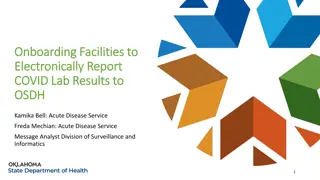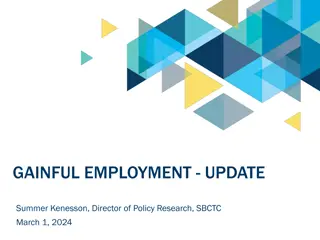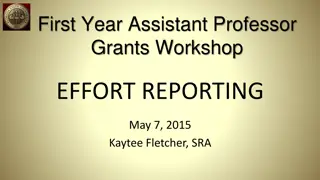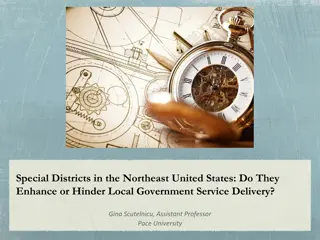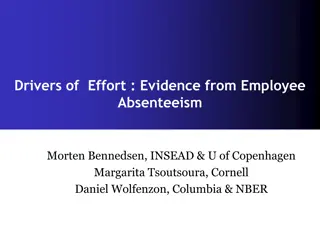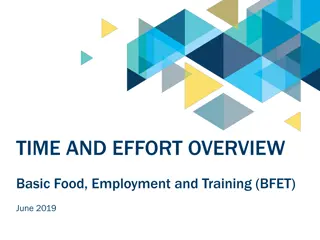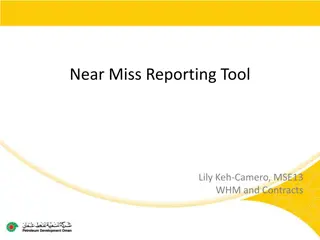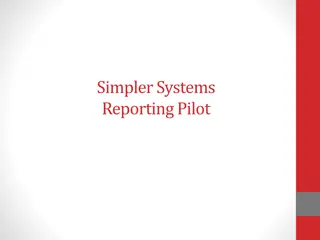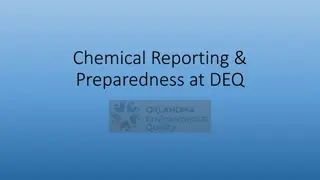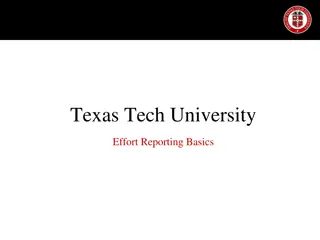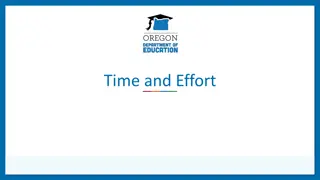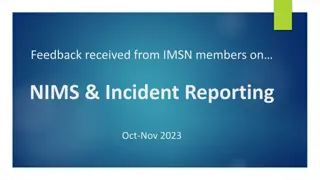Streamlining Time and Effort Reporting for Districts
Enhancing flexibility in time and effort reporting for school districts, the U.S. Department of Education aims to simplify documentation requirements, reducing burden especially for fixed-schedule employees. This change is significant for staff managing federal funds, emphasizing accountability and participation across various employee categories.
Download Presentation

Please find below an Image/Link to download the presentation.
The content on the website is provided AS IS for your information and personal use only. It may not be sold, licensed, or shared on other websites without obtaining consent from the author.If you encounter any issues during the download, it is possible that the publisher has removed the file from their server.
You are allowed to download the files provided on this website for personal or commercial use, subject to the condition that they are used lawfully. All files are the property of their respective owners.
The content on the website is provided AS IS for your information and personal use only. It may not be sold, licensed, or shared on other websites without obtaining consent from the author.
E N D
Presentation Transcript
Changes in time and effort reporting Additional flexibility for districts
Topics Reviewing the basics What is time & effort reporting? Why is time & effort reporting important? Who must participate in time & effort reporting? Changes in time & effort reporting What has changed? What do the changes mean for district staff? 2 Massachusetts Department of Elementary and Secondary Education
Time and effort basics: What is time & effort reporting? A federal requirement for documentation: All employees, including teachers, paraprofessionals, and other staff paid with federal funds must document the time and effort they spend within that program. The portion of the federally-paid salary should reflect the time and effort the individual has put forth for that federal program. 3 Massachusetts Department of Elementary and Secondary Education
Time and effort basics: Why is it important? Time and effort reporting is a form of accountability for the spending of federal funds: For Title I, time and effort reporting documents the work that an individual has completed on activities supported by the Title I grant 4 Massachusetts Department of Elementary and Secondary Education
Time and effort basics: Who must participate? All employees, including teachers, paraprofessionals, and other staff paid with federal funds, including staff who are: Full-time Part- and split-funded Stipended 5 Massachusetts Department of Elementary and Secondary Education
Changes in time and effort reporting The U.S. Department of Education (ED) has taken steps to reduce the burden of time and effort reporting as required under Office of Management and Budget (OMB) Circular A-87 Aim is to simplify time and effort reporting for 1. certain staff working on a fixed schedule or 2. staff working under a single cost objective but funded through multiple sources
Why the flexibility? Monthly time and effort reporting is burdensome Many district employees have fixed schedules (e.g., class schedules) that do not change from week to week and monthly records look identical with a new date and signatures each month Semi-annual certifications make more sense for district employees working a set schedule or working under one objective, even if they are funded through multiple sources 7 Massachusetts Department of Elementary and Secondary Education
Who and what? The following staff may be allowed to submit semi- annual certifications of time worked rather than monthly time and effort reports: Staff who work a fixed pre-determined schedule that includes activities in multiple cost objectives Staff who work on a single cost objective but are paid from multiple sources 8 Massachusetts Department of Elementary and Secondary Education
Current practice In practice, many staff have fixed schedules (e.g., class schedules) that do not change from week to week (meaning they carry out the same duties for the same amount of time each pay period) Monthly reports for such staff usually look identical every month, just updated with a new date and signatures
Change 1: Substitute system Districts may now implement a substitute system, allowing employees working a fixed schedule to use alternative documentation for supporting salaries and wages, such as a teaching schedule The employee would then certify semi-annually that the schedule reflects actual time worked in each activity for the period being certified 10 Massachusetts Department of Elementary and Secondary Education
Change 2: Single cost objectives A single cost objective is a single function or a single grant or a single activity. It is possible to work on a single cost objective even if an employee works on more than one Federal award or on a Federal award and a non- Federal award. The key to identifying a single cost objective is whether the employee s salary can be supported in full from each of the funding sources indicated. 11 Massachusetts Department of Elementary and Secondary Education
Current practice Based on long-standing federal guidance, staff funded through multiple sources typically complete monthly time and effort reports, even if all of their work activities are under a single cost objective
Single cost objective example A Example A: A district supports a supplemental math teacher to serve low-achieving students with 50% Title I, Part A and 50% local funds Teaching math to low-achieving students is a single cost objective because it can be fully supported under Title I, Part A. Only a semiannual certification is required. 13 Massachusetts Department of Elementary and Secondary Education
Single cost objective example B Example B: A district supports an elementary school teacher with local funds but also pays her with Title I, Part A funds to provide after-school tutoring for low- achieving students. Although the teacher is not paid with Title I, Part A funds to provide elementary education, the portion of her time spent on after-school tutoring is easily separated from her teaching position by her schedule. Accordingly, the after-school tutoring is a single cost objective and she need only file a semiannual certification. 14 Massachusetts Department of Elementary and Secondary Education
Single cost objective example C Example C: A teacher in a SW school is paid with local funds to teach 1st grade in the morning to decrease class size for reading & is paid for Title I, Part A funds to teach supplemental reading recovery in the afternoon. Both functions are fully supportable with Title I, Part A funds, and the schoolwide program constitutes a single cost objective. Only a semiannual certification is required even though the salary is supported by a Federal award and local funds & she conducts two different activities. 15 Massachusetts Department of Elementary and Secondary Education
Where can I find more details? DESE Title I website: http://www.doe.mass.edu/federalgrants/titlei-a/ U.S. Department of Education website: www2.ed.gov/policy/fund/guid/gposbul/time-and-effort- reporting.html
Next steps In order to implement this substitute system in your district, you need to: Ensure the system meets the minimum guidelines as published by ED (see document entitled ED substitute system guidelines ) Document your substitute system and retain for audit/monitoring Maintain on file a signed Substitute System Fixed Schedule Certification form (sample on ESE Title I website)
Questions? Contact: FederalGrantPrograms@mass.gov| 781-338-6230, or smazzarella@mass.gov | 781-338-3587
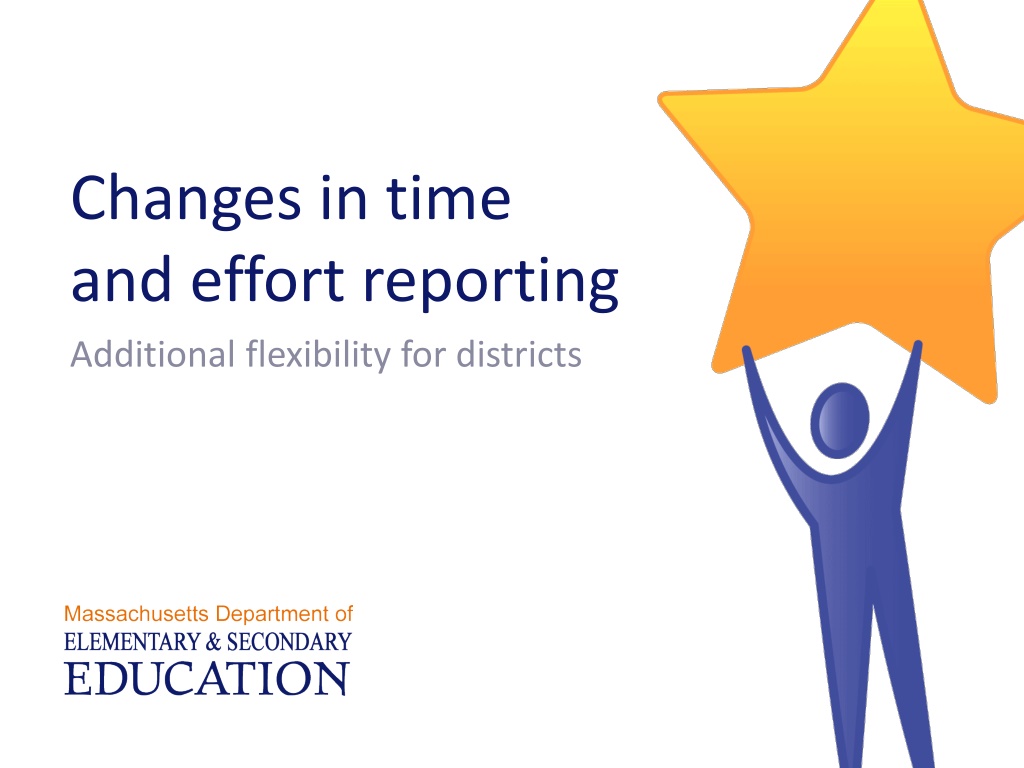
 undefined
undefined




